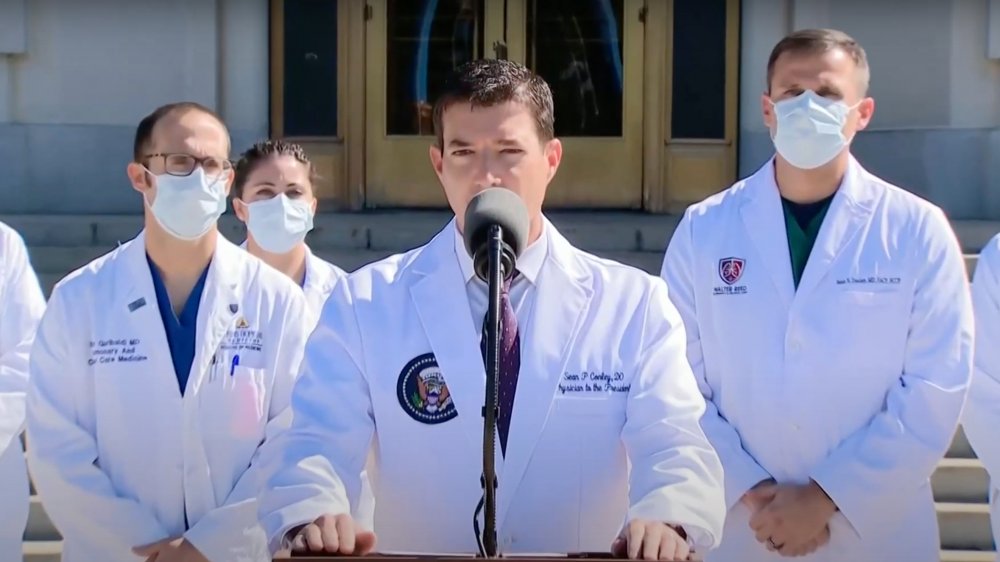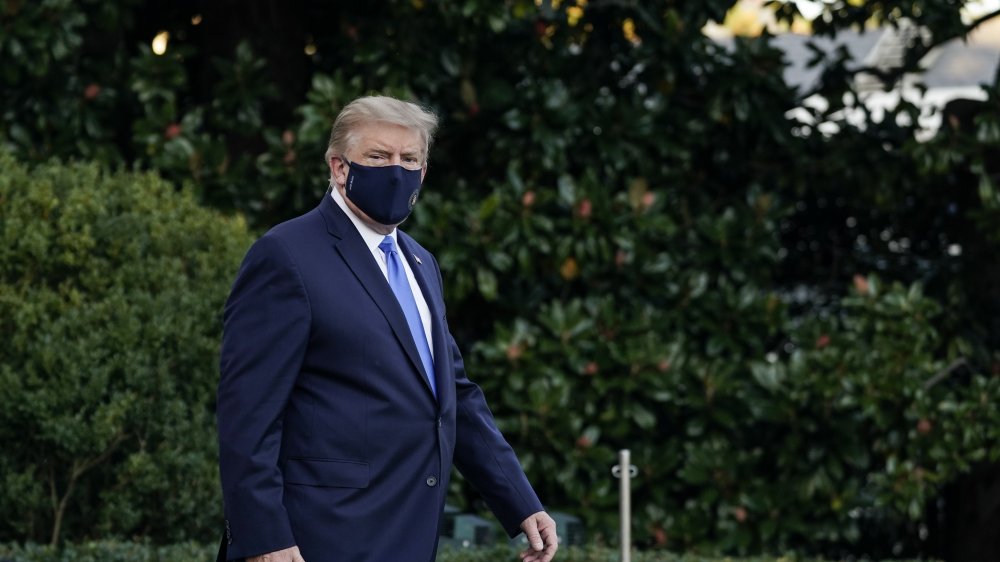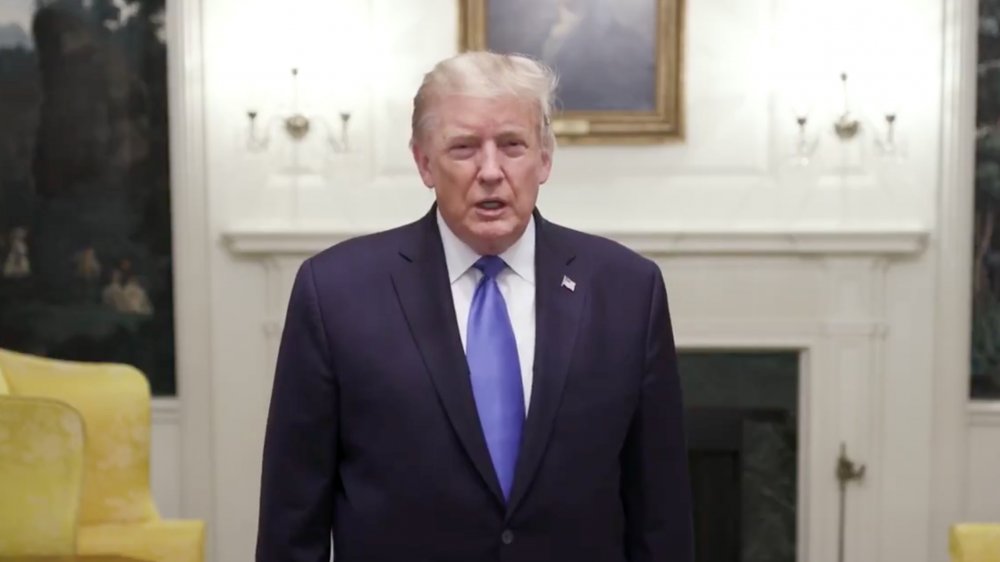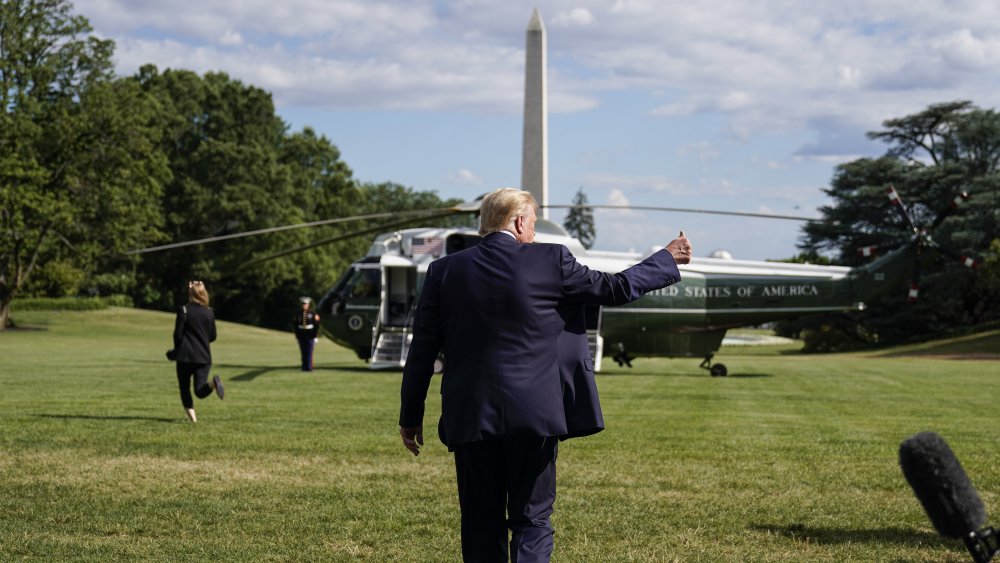Trump's Doctor Just Drastically Altered His COVID Timeline
News conferences are normally held to clear the air, to provide clarity and transparency to a situation that might be obscured by rumors and speculation. So when President Donald Trump's physician Sean Conley held his news conference outside Walter Reed Medical Center on Saturday morning to give the world an update on Trump's condition, many of us were looking for clarity. Conley said: "As reported yesterday [Friday], in consultation with this group, I recommended we bring the president up to Walter Reed as a precautionary measure to provide state-of-the-art monitoring and any care that he may need. Just 72 hours into the diagnosis now, the first week of Covid, and in particular days seven to 10, are the most critical in determining the likely course of this illness."
A second doctor from the medical pool, lung specialist Brian Garibaldi then mentioned the president's scheduled medical treatment, saying: "About 48 hours ago, the president received a special antibody therapy directed against the coronavirus. And we're working very closely with the company to monitor him in terms of that outcome. Yesterday evening, he received his first dose of IV Remdesivir and our plan is to continue a five day treatment course for Remdesivir" (via NPR).
Conley's comments provided no clarity
While it all sounds simple enough, Conley's original timeline of "72 hours into the diagnosis" meant that the president would have known he had tested positive midday Wednesday. Garibaldi's comment that Trump had received the experimental antibody about "48 hours ago" would have meant he had begun treatment on Thursday, which means a full day and a half would have passed before the White House admitted to beginning COVID treatments on Friday (via The New York Times). These revelations were later raised by reporters like CNN's Abby Phillip, who said: "The White House needs to clarify the timeline ASAP. If, based on the timeline provided by Dr. Conley, the president was symptomatic on Thursday and had tested positive for COVID-19 72 hours ago and yet carried on with his normal schedule, that would be shocking."
Two hours later, Conley issued a clarification through the White House, saying, "This morning while summarizing the president's health, I incorrectly used the term '72 hours' instead of 'Day 3' and '48 hours' instead of 'Day 2' with regards to his diagnosis and the administration of the polyclonal antibody therapy." He further clarified that Trump had first been diagnosed with the virus on Thursday evening and given the experimental antibody on Friday.
Conley's clarification only confused us more
While the walk back puts the timeline back into the order as we know it, Conley's slips suggested that the president knew he was ill before the information was made public. As CNN public health expert and professor of emergency medicine at Oregon Health and Science University Esther Choo pointed out (via Twitter): "if we count backwards, he [Trump] started to have symptoms by Thursday into Friday. And since we know typically coronavirus symptoms begin 4-5 days into the disease, if you count backwards it's likely that he had the disease and was most likely infectious on the top of that week. That takes us into the time of travel, the debate, many private meetings after the debates and fund raisers. It leaves open a whole world of possibility for every single person that crossed his path, and those who caught it at the same events."
Trump's vital signs are a cause for concern: Mark Meadows
Other matters arose that made clarity a further challenge. The president's chief of staff Mark Meadows told reporters after the medical briefing that Trump's vital signs were causes for concern and that the next two days would determine the outcome of the illness. "The president's vitals over the last 24 hours were very concerning, and the next 48 hours will be critical in terms of his care We're still not on a clear path to a full recovery," Meadows said, originally under the request of anonymity (via The New York Times). The comments were said to have made the president very angry, and prompted him to release a four-minute "proof of life" video on Twitter which has picked up over 600,000 likes.
Since then, Sean Conley released a memo saying, "President Trump continues to do well, having made substantial progress since diagnosis. This evening he completed his second dose of Remdesivir without complication... While not yet out of the woods, the team remains cautiously optimistic. The plan for tomorrow is to continue observation in between doses of Remdesivir, closely monitoring his clinical status while fully supporting his conduct of Presidential duties" (via Twitter).
Past presidents have fudged their health problems, too
To be fair, past administrations have played it fast and loose when it came to reports about the president's health. Woodrow Wilson played down the 1918 Spanish Flu pandemic and came down with it himself, though never publicized it. Grover Cleveland and Lyndon B Johnson underwent secret surgical procedures. Franklin D Roosevelt's health problems, which include high blood pressure, heart disease, and acute bronchitis (among other things) were downplayed during the elections — he died months later of a stroke. John F Kennedy suffered pain and illness and took as much as eight different medicines a day. Dwight D Eisenhower had a heart attack and hospitalized for six weeks.
University of Chicago professor of American politics William Howell is unsure about how transparent this White House will be. "He is obviously going to be eager to get back onto the campaign trail. He has all kinds of incentives to signal strength and to get back into the mix. He's going to want to." But, Howell adds: "This is a president who's been less than straightforward over the course of his presidency about all manner of factual issues. And so, [whether] is he to be believed is a good cause of real concern" (via AP).




